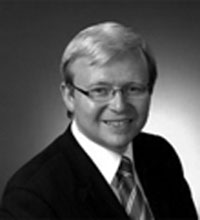Kevin Rudd

Kevin Michael Rudd was sworn in as the 26th Prime Minister of Australia on 3 December 2007.
Mr Rudd was born in the country town of Nambour in Queensland in 1957, the son of a share farmer and a nurse. Mr Rudd was educated at the Eumundi Primary School, Marist College Ashgrove and Nambour State High School, where he was Dux of the school. He joined the Australian Labor Party at the age of 15 in 1972.
Prior to entering Parliament in 1998, Mr Rudd worked as a diplomat, as a senior official in the Queensland Government, and as a consultant helping Australian firms to establish and build their business links in China and in Taiwan.
Mr Rudd gained his Bachelor of Arts (Asian Studies) degree with First Class Honours in 1981 from the Australian National University in Canberra. After graduation he was appointed to the Australian Department of Foreign Affairs as a cadet diplomat. He served in the Australian embassy in Stockholm and later in the embassy in Beijing as First Secretary. In 1988, Mr Rudd was promoted to the rank of Counsellor and later to the Senior Executive Service.
In 1988 Mr Rudd returned to Queensland to work as Chief of Staff to the Hon Wayne Goss, the Queensland Opposition Leader. Mr Goss made history the following year, leading the Queensland Labor Party back to government in its first election win since 1956. Mr Rudd served in the Goss Government first as Chief of Staff to the Premier and later driving the Government’s reform program as Director General of the Cabinet Office, the central policy agency of the Queensland Government. During this period Mr Rudd, a Mandarin speaker, was also appointed by Prime Minister Keating and the State Premiers to chair an inter- government committee to develop a National Asian Language and Studies Strategy for Australian schools.
Mr Rudd contested the Federal seat of Griffith for the Australian Labor Party in 1996. The Keating Labor Government was defeated at the 1996 election and Mr Rudd’s bid to win a seat in parliament was unsuccessful. Between 1996 and 1998 Mr Rudd then worked in business, primarily as the Senior China Consultant for KPMG Australia. His role focused on opening up trade and business opportunities for Australian corporates in China and Taiwan.
In 1998 Mr Rudd again contested the seat of Griffith and was elected to the Parliament of Australia. He was immediately elected Chair of the Parliamentary Labor Party’s Committee on National Security & Trade and served on a variety of parliamentary committees and taskforces. Following the November 2001 election, Mr Rudd was appointed Shadow Minister for Foreign Affairs, subsequently adding responsibilities for International Security in 2003 and Trade in 2005.
Kevin Rudd, Australia's 26th Prime Minister, held office from 3 December 2007 to 24 June 2010, and for 11 weeks in 2013. His election win in November 2007 brought Labor back into power after 11 years in opposition.
His government was characterised by a commitment to fairness, expressed in education and employment reforms, health delivery and financial initiatives such as taxation adjustments. Kevin Rudd pointed to a 21st-century social democracy where the responsibility of government was to offset ‘the inevitable inequalities of the market with a commitment to fairness for all’.
Like his predecessor Paul Keating, Kevin Rudd departed from firm Labor Party practice by selecting his own ministers, breaking the traditional role of the Caucus. He also broke with tradition to be the first Australian prime minister with a woman deputy, Julia Gillard.
An Indigenous welcome to country at the opening of Australia’s 42nd Parliament and the apology to Indigenous people on 13 February 2008 were historic highlights of the new Prime Minister’s first year.
In his first months in office, Kevin Rudd visited Indonesia, China and Japan, as well as the United States, the United Kingdom, East Timor, Papua New Guinea, and the Solomon Islands. During his 31 months in office, his time away on overseas trips totalled seven months.
At home the new government gave immediate priority to Labor’s key reform areas of education, employment, health and climate change. The most successful of these initiatives was the Fair Work Act, reversing the comprehensive workplace reforms of the Howard government. The Minister responsible for this portfolio, Julia Gillard, was also responsible for education, where reforms such as the ‘Building the Education Revolution’ scheme and the ‘MySchool’ website had mixed outcomes.
An outstanding success of Kevin Rudd’s term as prime minister was the government’s management of the global financial crisis of 2008. Australia was one of the few developed economies where the impact was effectively cushioned by government initiatives. The stimulus packages implemented by the Rudd government followed the principles of Depression-era economist John Maynard Keynes by funding public works projects to reduce unemployment and support industrial, retail and services sectors by maintaining buying power.
The government’s policy back-step on climate change was a factor in declining support for Kevin Rudd in 2010. The mining industry’s response to his government’s ‘super profits’ tax also generated influential opposition.
On 24 June 2010 Kevin Rudd became one of the few leaders to be removed by their own party in their first term as prime minister. His two and a half years in office was, however, an above-average term – only 10 of Australia’s 26 prime ministers remained in office more than three years.
On 27 June 2013, the Governor-General again swore in Kevin Rudd as Prime Minister after he was voted Leader of the Parliamentary Labor Party.
Document Actions

 Like us on Facebook
Like us on Facebook